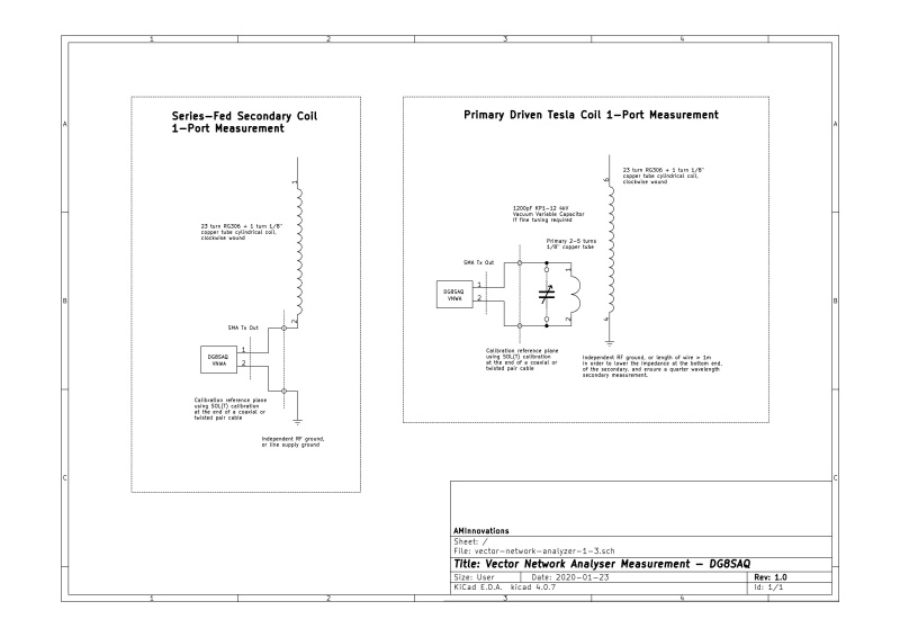This post on the Vector Network Analyser, the DG8SAQ by SDR-Kits[1-3], is the first in a sequence looking at how to use advanced test equipment to measure the properties, characteristics, and electrical parameters associated with Tesla coils and TMT transmission systems. The small signal ac input impedance characteristics Z11, and also the transmission gain characteristics S21, are used a lot in the experiments and measurements presented in this website, and yield a lot of fascinating and intricate dynamic data that can assist in the design, operation, matching and tuning of experimental apparatus suitable for experiments in the displacement and transference of electric power.
Vector network analysis is a vast and well-documented subject which covers the vector response of an electrical network to a frequency stimulus, and analyses the real and imaginary components of both the reflected and transmitted components of that stimulus. The results of this frequency analysis are detailed measurement data of the magnitude and phase of reflected and transmitted scattering parameters such as S11 and S21, which combined with a known and carefully measured calibration, yield impedance measurement parameters like Z11 which can be displayed and stored in a variety of different formats.
The purpose of this post is not to cover in detail the theory and prior-art of vector network analysis, which is more than adequately treated in the field, but rather to demonstrate how to use a vector network analyser to gain practical measurements from Tesla and TMT based systems. Some good references[4-7] for further study of this subject area are presented at the end of this post. The usb VNA demonstrated in this post is both sufficiently accurate, and yet affordable, for the expert amateur inventor, researcher, experimenter, or engineer. The results obtained using this instrument, and presented on many of my posts on this website, have been found to correspond with good accuracy and feature detail, when compared to measurements taken using a professional grade VNA, a Hewlett-Packard (HP) 4195A[8].
The 4195A although from the late-80s, and very much an HP flag-ship at the time with a list price, including accessories, in that era of over $50k, and is still actively used in some research labs due to its high accuracy, high dynamic range, and measurement mode flexibility (network, spectrum, and impedance) from 10Hz – 500MHz. Fully working and calibrated examples can still fetch as much as $5k on Ebay and from used test equipment suppliers. The HP 4195A will be presented and compared in another post in this equipment sequence.
The following videos looks in detail at the setup, calibration, software, and measurement of a cylindrical Tesla coil using the usb connected DG8SAQ VNWA, and is intended as a practical introduction to start using a VNA to gain useful measurement data. The first video focuses on the practical setup, calibration, and measurement, and considers and demonstrates the following:
1. An introduction to Tesla coil measurements using a usb connected vector network analyser (VNA).
2. Connecting the VNA directly to the secondary of a Tesla coil for series-fed measurements.
3. Connecting the VNA to the primary of a Tesla coil to measure Z11, the small signal input impedance from the perspective of the generator (the VNA).
4. Connection considerations and methods when using coaxial, and twisted-pair cables.
5. Consideration of calibration reference plane, and techniques to extend the reference plane directly to the primary coil inputs.
6. Calibration of the VNA for Z11 measurements using a short, open, and 50Ω termination.
7. Calibration and measurement procedure for a primary driven cylindrical Tesla coil.
8. Calibration and measurement procedure for a series-fed cylindrical secondary coil.
Figure 2 below shows the schematic for the series-fed and primary driven VNA measurement setup. The high-resolution version can be viewed by clicking here.
The second video focuses on using the DG8SAQ software to calibrate, measure, display, and store the data , and demonstrates the following:
1. Calibration preparation in setting frequency scan bandwidth, number of data points in the scan, and hence the scan rate.
2. Calibration of the VNA for Z11 measurements using a short, open, and 50Ω termination.
3. Display forms including cartesian, polar, and smith chart, trace scaling, and display parameter selection for the measured data.
4. Calibration, measurement procedure, and display of results for a primary driven cylindrical Tesla coil.
5. Calibration, measurement procedure, and display of results for a series-fed cylindrical secondary coil.
6. Data exporting to file, and loading from file to display.
In summary, the SDR-Kits DG8SAQ VNWA has proven to be a reasonable cost, good accuracy, and flexible addition to the lab test equipment, and is capable of a wide range of different measurements, which contributes useful data in the design, implementation, and operation of Tesla coils and TMT transmission systems.
1. Baier, T., A Small, Simple, USB-Powered Vector Network Analyzer Covering 1 kHz to 1.3 GHz, QEX Jan/Feb 2009
2. SDR-Kits, Introducing the DG8SAQ VNWA 3 Low Cost 1.3 GHz Vector Network Analyzer, SDR-Kits DG8SAQ
3. SDR-Kits, Software & Documentation, SDR-Kits DG8SAQ Documentation
4. Keysight Technologies, Understanding the Fundamental Principles of Vector Network Analysis, Application Note 5965-7707
5. National Instruments, Introduction to Network Analyzer Measurements, Fundamentals and Background, NI RF Academy
6. Baier, T., Experiments with the DG8SAQ VNWA and the SDR-Kits Test Board, SDR-Kits DG8SAQ Tutorial
7. Baier, T., Your RF Cable, The Unknown Entity, Ham Radio 2018
8. Keysight Technologies, Network Analyzers, Combined Network/Spectrum Analysis, 10 Hz to 500MHz, HP 4195A



